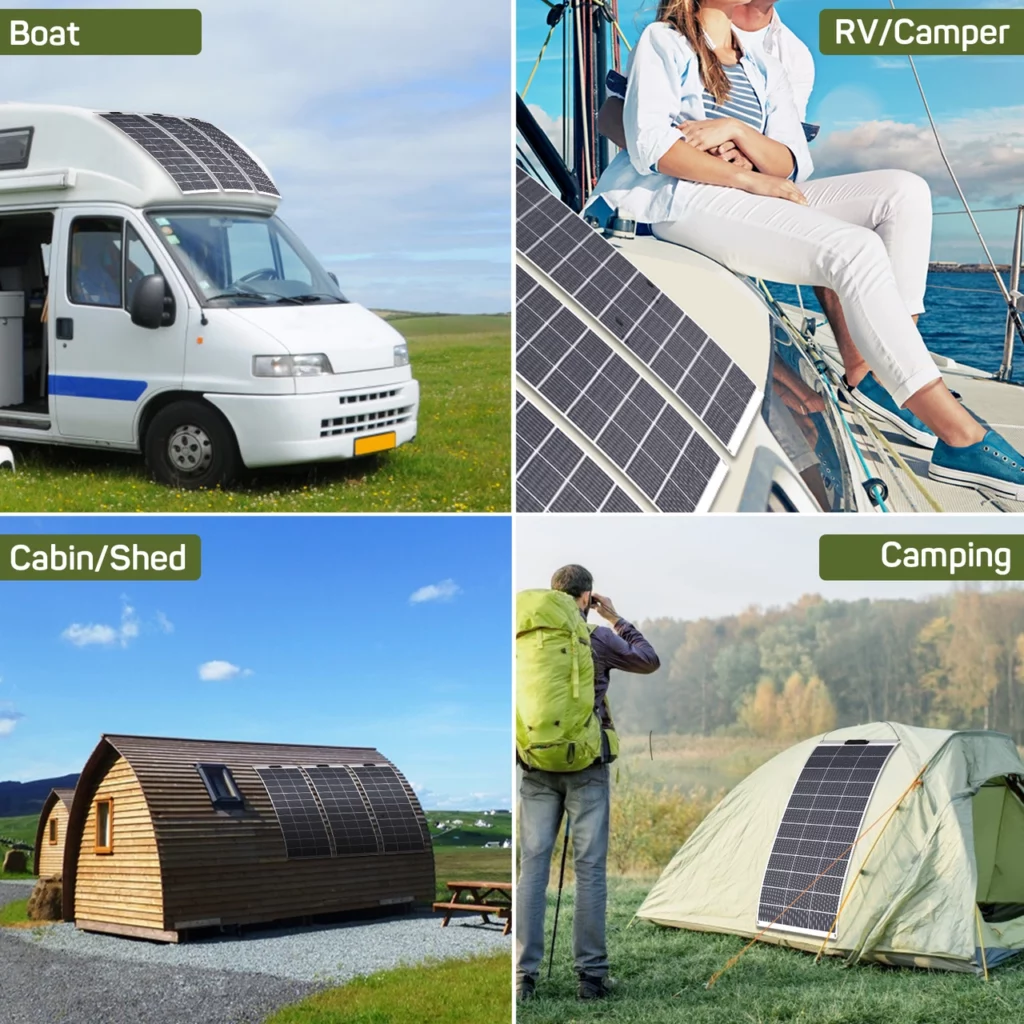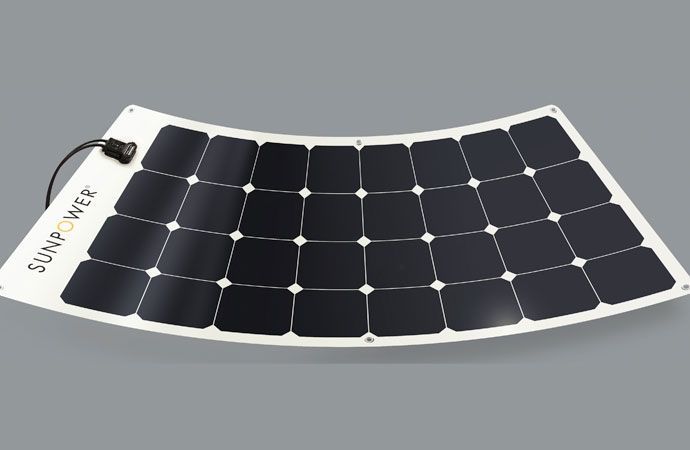The solar panels you see on rooftops normally have rigid photovoltaic cells and frames, which means they need flat surfaces. Solar panels are also larger and heavier than they may appear when seen from the ground.

source: HQ Solar Power
Their exact dimensions vary by brand and model, but most residential panels are close to 65” x 40”, while having a thickness of around 1.5”. They are also quite heavy, ranging from 40 to 50 pounds. However, flexible solar panels are a viable option in cases where the size and weight of traditional PV modules limit their use.
Flexible solar panels are less standardized than their rigid counterparts, which means you can find a much wider range of sizes, wattages, and prices. Unfortunately, this also means low quality products are very common, and you must be careful when comparing your options.
As a bare minimum, you should look for flexible solar panels with certification marks like UL and ETL to ensure safety. Electrical products that have not been properly tested are more likely to suffer faults or start a fire.
Thanks to their flexibility, these solar panels can be used on surfaces that are not suitable for traditional PV modules.
For example, installing a panel with a rigid 65” x 40” frame on a vehicle or window is impractical, and even dangerous. On the other hand, flexible PV modules can be installed on many types of surfaces, and they use simpler installation methods thanks to their lower weight.
Flexible solar panels are also a much better option for DIY projects, being smaller and lighter than rigid PV modules. Actually, handling conventional solar panels is dangerous when you lack proper training, while flexible photovoltaic modules are user-friendly.

In this guide, we will compare both types of solar modules, while giving some recommendations when purchasing and using flexible solar panels.
Comparing Rigid and Flexible Solar Panels: Pros and Cons
Like in any engineering decision, flexible solar panels have advantages and limitations when compared with traditional rigid modules. They are more affordable and adaptable, while being much easier to install, but traditional solar panels tend to have better efficiency and durability. The following table summarizes the pros and cons of both solar panel types:
| Type of Solar Panel | Advantages | Disadvantages |
| Rigid solar panels | Higher efficiency
Longer service life, typically 25 years or more More durable than flexible panels Quality brands have product warranties of up to 25 years |
More expensive
Require a professional installation Only suitable for flat surfaces with enough structural capacity Limited applications due to their thick frame (around 1.5 inches) Difficult to uninstall and relocate |
| Flexible solar panels | Lower cost
Simple installation methods User-friendly and suitable for DIY projects Suitable for more surfaces thanks to their flexibility Some flexible panels have a thickness of less than 0.01” |
Shorter service life
Less durable Lower efficiency in general, which means fewer watts per square foot Warranties are much shorter compared to rigid solar panels |
Both types of solar panels are based on the same physical principle: using a photovoltaic material that generates voltage and current when exposed to light and placing it under the sun.
The PV material used by most solar panels is crystalline silicon, but there are alternatives like cadmium telluride (CdTe) and copper indium gallium diselenide (CIGS).
You may have heard about thin-film solar panels, and they are sometimes confused with flexible solar panels. However, these terms actually refer to different features of a solar panel.
- Thin-film solar panels use thin layers of photovoltaic material on their surfaces, instead of crystalline silicon cells. Some materials commonly used in thin-film modules include CdTe, CIGS, and non-crystalline or amorphous silicon.
- The concept of flexible solar panels is broader, referring to all solar panels that can be bent to some degree.
Thin-film solar panels are available in both rigid and flexible versions. The same applies for crystalline silicon modules: the traditional design uses solar cells with rigid frames, but there are also silicon modules with smaller wafers mounted on flexible surfaces.
Since flexible solar panels are lightweight, their attachment methods are also much simpler. When using traditional modules, you need a racking system with penetrating or ballasted supports.
On the other hand, flexible solar panels can be simply pasted in place with adhesives, or they can attach to metallic surfaces with magnets. These methods are not suitable for rigid solar panels, due to their dimensions and weight.
When Should I Use Flexible Solar Panels?
In general, flexible solar panels are recommended for curved or vertical surfaces, and when you need a lightweight and portable energy system.
For example, if you want solar power for a recreational vehicle or a boat, flexible PV modules can easily attach to most surfaces. Traditional solar panels are impractical in these cases, due to their rigid frame.
- Flexible solar panels can also adapt to aerodynamic surfaces, which means they don’t have a negative impact on the fuel consumption of vehicles.
- On the other hand, rigid solar panels add significant weight and air drag, which is detrimental for fuel efficiency.
Thanks to their low weight and ease of installation, flexible solar panels are also suitable for windows and other vertical building surfaces. Traditional solar panels can also be installed on vertical surfaces, but they add plenty of weight to walls, making the racking system more expensive.
Walls of homes and buildings also tend to get less sunshine on average, and hence justifying the higher cost of rigid solar panels can be difficult.
Since flexible solar panels can be easily carried around, they are also ideal for mobile device charging.
- When your smartphone or tablet is running low and there is no power outlet available, you can set up a flexible solar panel where it will get maximum sunshine. This is especially useful for camping trips and other outdoor activities.
- You can also combine a flexible solar panel with a portable power bank and use it for small appliances and LED lights.
Flexible solar panels are also recommended if you’re a DIY enthusiast. Thanks to their lightweight and compact design, they can be handled more easily.
Installing traditional solar panels is only advised if you have received proper training: they are large and heavy, the racking system must be firmly attached, and there are high DC voltages involved.
In the case of rooftop installations, you also need adequate gear and training to work at height. Flexible solar panels can be installed on many surfaces with adhesives and magnets, making them a much better option for a DIY project.
If your goal is using solar energy to cut electricity bills in a home or business, a conventional solar PV system is the recommended option. Rigid solar panels are more efficient and durable, and they can generate electricity for decades with minimal maintenance.
Flexible solar panels are more adaptable and user-friendly, but this comes at the cost of efficiency and service life. There are now rigid solar panels that operate above 22% efficiency, while most flexible panels are below 15% efficiency, according to EnergySage.
Recommendations for Buying Flexible Solar Panels
As mentioned before, rigid solar panels tend to come in standard sizes like 60 cells and 72 cells, and 66-cell panels have also become popular recently. On the other hand, flexible solar panels have a much wider product variety. However, having too many options can be detrimental, especially when there are also low-quality products in the market.
When purchasing any electrical device, not only solar panels, one of the best recommendations is always looking for certification marks. These indicate that the product has been successfully tested under stringent laboratory conditions, and it’s considered safe to use if you follow the product instructions.
The following are some of the most common certification marks:
- UL – Underwriters Laboratories
- ETL – Intertek, which follows the same standards as UL
- CSA – Canadian Standards Association
- CE – Conformité Européenne
Flexible solar panels without certification marks are much more likely to give you trouble, and this includes electrical faults and possibly fire. Just keep in mind that some products have counterfeit certification marks: when in doubt, you can visit the official website of the respective mark and search for the product.
Before using a flexible solar panel, make sure you check the maximum bending angle specified by the manufacturer. You should never bend the solar panel beyond this angle, or it can be permanently damaged. This is especially important if you intend to use flexible solar panels on a curved surface – they should be able to bend far enough to follow its curvature.
When purchasing flexible solar panels, you also need to consider the intended application. For example, a foldable panel that fits in your pocket might be enough to recharge your smartphone, but not if you intend to use several appliances.
Flexible solar panels are available in many wattages and sizes, and pricing is also very variable. You might find 5-watt portable panels that fit in your pocket for less than $25, or 200-watt panels for over $300. The following are some brands that offer high quality:
Rigid solar panels from SunPower are characterized by their high efficiency, which is currently the best in the industry (as of March 2022). This also applies for their flexible solar panels, which reach up to 23% efficiency – much higher than the typical efficiency range of flexible modules.
Since flexible solar panels are designed to be portable, many manufacturers also offer compatible power banks. These have built-in batteries, charging ports when you can connect solar panels, and multiple power outlets for AC and DC devices.
By combining flexible solar panels with portable power banks, you get an off-grid renewable energy system that can be carried anywhere.